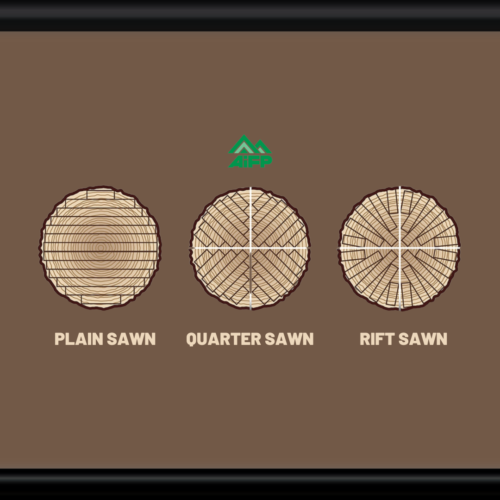Plain Sawn, Quarter Sawn, and Rift Sawn Wood Explained
When it comes to lumber and other building materials, our traders are experts. Not only do we provide our partners with key industry insights on lumber futures, but we also have an extensive knowledge of the milling process, the diverse types of lumber, and how it’s best utilized. In today’s blog, our lumber experts discuss plain sawn vs. quarter sawn vs. rift sawn wood.
What is Plain Sawn Wood?
Also known as flat sawn wood, plain sawn wood is produced by making a cut on a tangent to the circumference of the log and then making each additional cut parallel to the one before. Because it’s the most simple, cost-effective way to mill a log into planks, this type of wood cut tends to be the most readily available.
What are the Advantages of Plain Sawn Wood?
Plain sawn wood produces the widest possible boards with the least amount of log waste, making it both more cost-effective and more sustainable than other types of wood cuts. These wood cuts also produce unique, attractive boards with beautiful loops and growth swirls.
What are the Disadvantages of Plain Sawn Wood?
While plain sawn wood is readily available, relatively inexpensive, and distinctly attractive, it is not as dimensionally stable as other types of wood cuts. When using plain sawn lumber, for example, you need to account for more wood movement, as the boards tend to expand and contract with changes in humidity. As the wood dries and ages, grain tension can also make plain sawn planks cup, twist, and bow.
What is Quarter Sawn Wood?
Quarter sawn wood is produced by first cutting the log into quarters. From there, mills plain saw each quarter with the growth rings generally 60-90 degrees to the face of the board, which results in a more linear grain pattern.
What are the Advantages of Quarter Sawn Wood?
Because of its tight grain pattern, quarter sawn wood is stronger than plain sawn wood. It also tends to twist and cup less because of its smaller surface area and is less likely to split during construction. While you still have to account for wood movement in quarter sawn timber, it expands vertically instead of horizontally. Quarter sawn wood also tends to wear more evenly while still producing an attractive grain pattern, which is long and straight. It also has a smoother surface than plain sawn lumber.
What are the Disadvantages of Quarter Sawn Wood?
Quarter sawn lumber is more labor intensive to produce and it produces more waste than plain sawn wood, which makes it more expensive to purchase. Because of the cut, quarter sawn boards are generally smaller and more narrow than plain sawn boards.
What is Rift Sawn Wood?
Rift sawn wood is milled perpendicular to the growth rings, which are between 30 and 60 degrees to the face of the board. Like quarter sawn lumber, rift sawn lumber produces a linear, straight wood grain, which tends to look more consistent than both quarter sawn and plain sawn wood.
What are the Advantages of Rift Sawn Wood?
Rift sawn wood is the most dimensionally stable cut of wood available. The long, straight grains also produce the most consistent looking patterns.
What are the Disadvantages of Rift Sawn Wood?
Not only does milling rift sawn lumber take more time and labor than other wood cuts, but it also produces the most waste. That’s why rift sawn wood tends to be considerably more expensive than both quarter sawn and plain sawn wood.
Are you in the market for wholesale lumber from a company you can trust? Contact AIFP today. Whether you’re looking to stock up on cedar products, Southern yellow pine, or Canadian spruce, pine, and fir, we’ve got you covered. In the meantime, check out our lumber blog where we discuss everything from hardwood vs. softwood to what you need to know about cedar siding.

Jump Start Your Career
Up for the challenge? We'll give you the tools to excel. AIFP is continually growing. We recruit new traders year-round.
